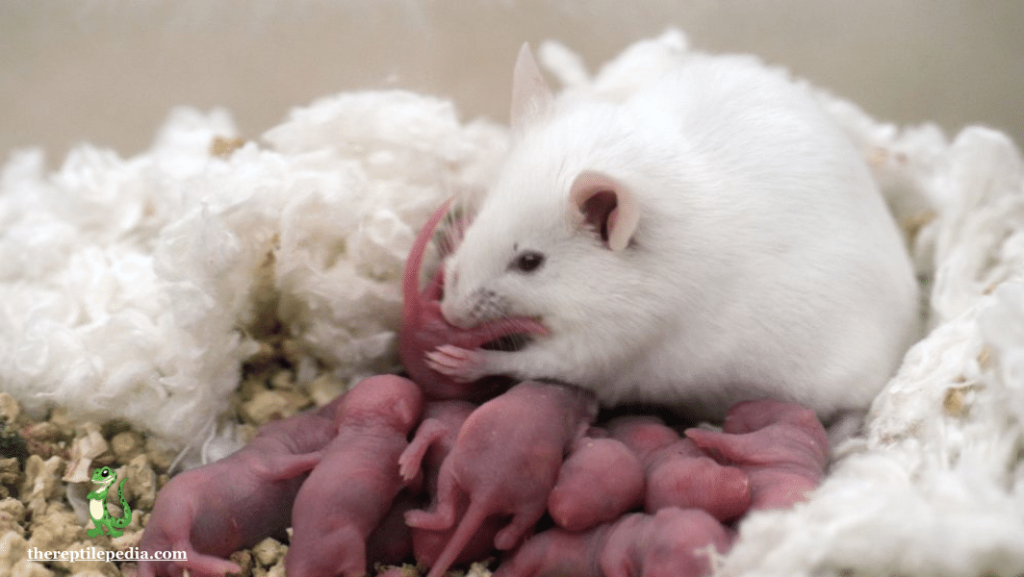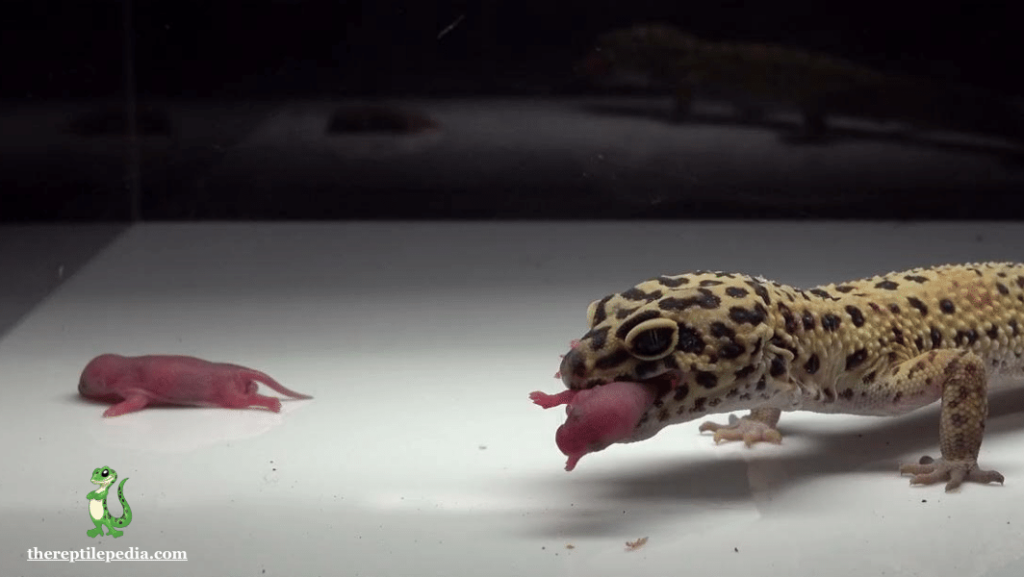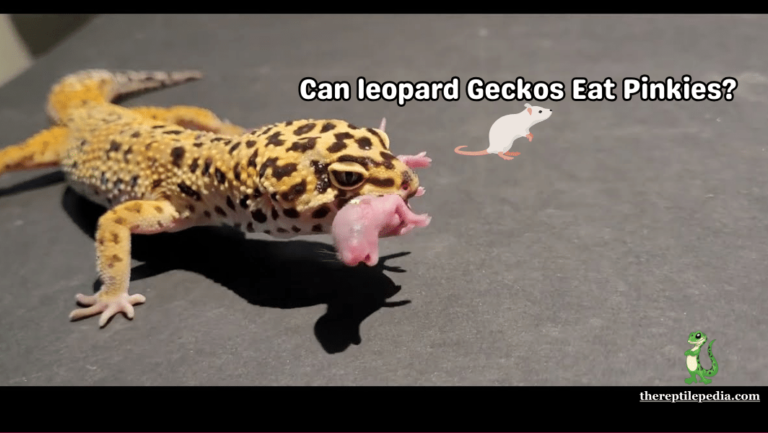As a gecko owner, I often wonder about the optimal diet for my pet. It’s well known in the reptile community that leopard geckos eat pinkies , but should they? This article aims to provide crucial information and shed light on this topic. While pinkies are full of nutrients and proteins, beneficial for young and growing geckos, they should not be a regular diet component.
From personal experience, I’ve observed that feeding pinkies more than 2 times a month can lead to dietary imbalances. For young geckos, who require more proteins and nutrients, pinkies can be a good, occasional boost. However, it’s not recommended for adult leopard geckos to have pinkies as a staple in their diet. In essence, while pinkies can be healthy in moderation, they shouldn’t dominate your gecko’s meal plan. This approach ensures a healthy, balanced diet, sustaining the wellbeing of your cherished pet.
Table of Contents
Why Would a Leopard Gecko Eat a Pinkie?
In the world of leopard geckos, pinkies represent a curious but crucial part of their diet puzzle. While these geckos typically feast on insects, which are good sources of protein, pinkies trump even crickets in nutritional value. The fact is, pinkies are packed with calcium, vitamins, and minerals – all essential for a gecko’s growth and nutrition. However, there’s a catch. Pinkies also contain a higher fat content, which isn’t ideal for leopard geckos on a regular basis.
As an owner, I’ve learned that while pinkies can be an important dietary addition, especially for young geckos needing that extra growth boost, they shouldn’t be the mainstay. It’s a sad thing to realize that too much of a seemingly good thing can be detrimental. So, while we can usually find pinkies readily, it’s pivotal to balance their use with the regular insect-based diet of your pet. This ensures they get the right mix of nutrients without overloading on fat.
What is a Pinkie?

A pinkie is essentially a young rat or mouse, typically ranging from a day to 5 days old. These little creatures get their name from their distinctive coloration, though you might occasionally find darker cubs. Nutritionally, pinkies are a powerhouse; they contain 4 to 15% fat depending on their age, and a substantial 55 to 65% crude protein. Additionally, they are rich in calcium, vitamins, and minerals – nutrients passed on from the mother to the pinkie.
For reptile owners, pinkies are a popular choice as they provide a valid source of essential nutrients. They are widely sold in pet stores as food items and are considered a treat for pets like leopard geckos. Pinkies offer a balanced mix of protein, calcium, vitamins, and minerals, making them a beneficial, albeit occasional, addition to a reptile’s diet.
Is Feeding Pinkies Good For Geckos?
When considering a Leopard gecko’s diet, which usually contains crickets, bugs, and mealworms, introducing pinkies can be a significant change. These pinky mice are packed with a large number of nutrients, making them a potentially healthful addition. However, it’s important to note that pinkies also have a moderate amount of fat. While this makes them suitable and easily digestible for geckos, caution is needed since the protein content in pinkies is too high for regular feeding.
Feeding your gecko with pinkies should be done safely. Ensure they are free of parasites to prevent any serious problems. While pinkies are considered Safe For Geckos, they should not dominate their diet. Moderate Fat levels in pinky mice make them a good fit for occasional feeding, but over-reliance can lead to health issues. Always keep in mind the balance of nutrients and the need for variety in your gecko’s diet.
Good Reasons Leopard Geckos Eat Pinkies
Despite some pushback from leopard gecko owners regarding feeding pinkies to their Leos, there are excellent reasons for mixing these into your pet’s diet. From a humane and purist diet standpoint, offering pinkies provides a nutritional variety that can benefit your gecko. Pinkies, when fed responsibly, can contribute to a well-rounded diet, ensuring your leopard gecko receives all the essential nutrients for optimal health. It’s all about balancing their regular insect-based meals with these occasional, nutrient-rich treats.
Your Leopard Gecko Is Pregnant
When your leopard gecko is pregnant or gravid, their diet needs special attention, especially in vitamins, minerals, and protein to produce healthy eggs. Feeding a pinkie occasionally can significantly satisfy these increased nutritional needs. This practice helps the female leopard gecko to not only lay healthier eggs but also ensures a higher rate of survival for the offspring. Moreover, after laying the eggs, pinkies can aid the mothers in recovering faster, providing a quick, nutrient-rich boost that supports their health during this demanding phase.
ALSO READ: Can Leopard Geckos Eat Stink Bugs?
Optimizing Growth: Pinkies for Enhancing Leopard Gecko Size
For pet owners aiming to bulk up their leopard gecko, incorporating a pinkie into the diet can be an effective shortcut. While there’s no harm in owning slightly fat pets, caution is essential to prevent obesity. Feeding a pinkie should be a well-considered decision, not a frequent indulgence. It’s about creating a balanced diet that centers on overall health, rather than going overboard with high-fat foods. Properly planned, a pinkie can be a beneficial supplement for your gecko’s growth, provided it’s done judiciously to avoid any health problems.
Diet Diversity
As a pet owner, I understand that owning leopard geckos can sometimes feel boring when it comes to their diet. These reptiles have the ability to thrive on an insect-based diet, happily munching on crickets, cockroaches, insect pupa, and beetle larva throughout their entire lives without a complain. It’s a good thing that these food items are readily found at a low price in pet stores.
However, to keep things interesting and provide variety in food, giving a pinkie now and then can be likened to treating yourself with an oversized hamburger for a meal. It tastes great and makes your pet feel good. So, go ahead and mix things up with a pinkie, but remember not to make it an every day occurrence. This approach ensures a balanced diet while adding an occasional, exciting element.
The Thrill of Feeding: Observing Leopard Geckos Hunt Pinkies
For many, including myself, there’s a certain thrill in watching leopard geckos become active hunters as they stalk and pounce on pinkies. It’s not a sadistic reason for feeding them these treats, but rather an appreciation of their natural behaviors. Whether using live or frozen pinkies delivered with a pair of tongs, observing the precise moment when the gecko quickly darts forward, measuring its prey with a signature tail quiver before the pounce, is fascinating. It offers a glimpse into their instincts and prowess.
However, as a responsible pet owner, I always ensure that this practice does not inflict pain on the unsuspecting prey item. The idea is to mimic their natural hunting experience in a controlled environment, making it a different yet enriching experience compared to feeding them crickets or mealworms.
Pros And Cons of Feeding Your Leopard Geckos Pinkies
Feeding pinkies to leopard geckos is a topic of debate among reptile enthusiasts. Understanding the pros and cons is crucial for responsible pet ownership.
Pros:
- Nutritional Value: Pinkies are rich in proteins, calcium, and essential nutrients that can be beneficial, especially for young or gravid geckos.
- Variety in Diet: They add diversity to the gecko’s diet, breaking the monotony of an insect-only menu.
- Growth Support: For growing geckos, pinkies can provide the extra nutrients needed for healthy development.
- Recovery Aid: Post egg-laying, pinkies can help female geckos regain strength and health.
Cons:
- Risk of Obesity: Overfeeding pinkies can lead to obesity in leopard geckos due to their high fat content.
- Digestive Issues: Pinkies are not a natural part of a gecko’s diet and can cause digestive problems if fed regularly.
- Nutritional Imbalance: Relying too heavily on pinkies can lead to an imbalance in the gecko’s diet, lacking in other essential nutrients found in insects.
- Feeding Challenges: The size of pinkies might be too large for some geckos, leading to potential choking hazards or digestive complications.
How Many Pinky Mice Can You Feed To Your Geckos?

Incorporating pinkies into your gecko’s diet requires a balanced approach, as these are full of nutrients but should not form the regular diet. For an adult gecko, feeding one pinky mouse per month is generally safe, ensuring that the nutrients are safely consumed without overwhelming their system. On the other hand, young geckos in their growing phase can benefit from 2 to 3 pinkies a month. These provide the necessary proteins and calcium crucial for their growth, keeping them safe, healthy, and happy.
However, it’s important to remember that pinkies contain extensive amounts of proteins and calcium. Overfeeding, especially in larger amounts than recommended, can be dangerous to the health of your gecko. The size of the pinky relative to your Leo’s stomach should be considered to ensure they can digest them easily. As a gecko owner, taking care in feeding a diet that contains pinkies only as an occasional or monthly snack is essential. For more info on specific dietary needs, you might want to visit the gecko diet folder.
ALSO READ: Why Is Your Leopard Gecko Digging
Optimal Timing for Feeding Pinkies to Your Geckos
Deciding when to feed pinky mice to your geckos depends on their specific needs and life stages. Generally, the best time to include pinkies in their diet is during their growing age, where they require more nutrients to grow healthily. For a Growing Gecko, pinkies can be a good source of essential nutrients, especially fats, which are important for their development. However, it’s crucial to keep in mind that pinkies should not be a staple and should only be fed on an occasional or non-regular basis. While some owners may want a slightly fatter gecko, overfeeding pinkies can lead to health issues, so moderation is key to maintaining their optimal health.
Essential Considerations Before Feeding Pinkies to Your Gecko
Before introducing pinkies to your gecko’s diet, ensure the following:
- Purchase pinkies that have been raised in a laboratory to ensure they are free of parasites.
- Avoid potential infections in your geckos by choosing parasite-free pinkies.
- Consider the size of the pinkies; they should be small enough for your gecko to easily swallow.
- Feed pinkies as an occasional diet supplement, not a regular meal.
- Pay attention to the age of the pinky mice; they should ideally not be greater than 5 days old for appropriate size and nutrition.
These steps will help in maintaining the health and wellbeing of your gecko while incorporating pinkies into their diet.
Potential Risks of Feeding Pinkies to Leopard Geckos
While pinkies can be a nutritious addition to a gecko’s diet, they can also cause serious problems if not managed correctly. Feeding pinkies more than once a month can lead to obesity, weakness, and even laziness in geckos. These small mammals, though rich in nutrients, contain a large amount of moisture and excess fat that may result in digestive issues. Additionally, the size of the pinky is crucial; if too big, it can damage the esophagus or cause injuries, potentially leading to infection. It’s important to understand that pinkies should not form the ideal diet for Leos on a regular basis. Instead, they should be used sparingly to avoid health complications like illness or in severe cases, death.
Final Thoughts:
As a pet owner, the decision to feed your Leo a pinkie falls entirely on you. While pinkies can be a special diet item for addressing certain dietary needs, they should be given sparingly. Think of them as a rare treat, not a primary diet component for your leopard geckos. The key is to balance the advantages, such as nutritional value, with the potential disadvantages like health risks from overfeeding. Ultimately, each gecko is unique, and as owners, we must decide what’s best for our pets’ long-term health and happiness.
ALSO READ: Leopard Gecko Pale And White
FAQs:
-
Do geckos eat small rats?
Geckos generally do not eat small rats. Their diet predominantly consists of insects such as crickets, mealworms, and cockroaches. Larger species might occasionally consume small mammals, but it’s not typical for most geckos, especially those kept as pets, due to their size and natural feeding habits.
-
What can geckos not eat?
Geckos should avoid certain foods for their health and safety. They cannot eat fruits, vegetables, dairy, or any processed human foods, as these can cause digestive issues. Chocolate, caffeine, and avocado are toxic to them. Feeding them wild-caught insects can also be harmful due to potential pesticides. Stick to a diet of safe, commercially-bred insects for optimal health.

